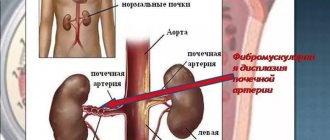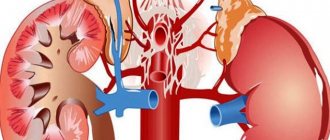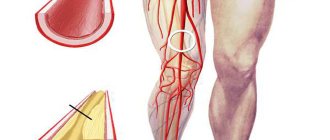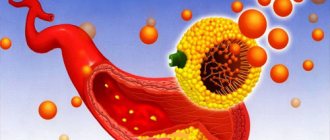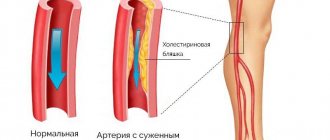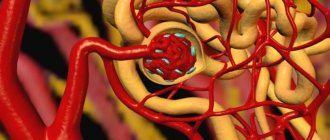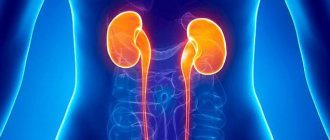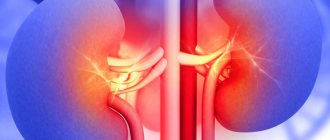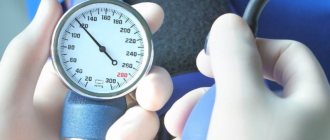- July 6, 2018
- Cardiology
- Olga Simchenko
Vasorenal hypertension is a hypertensive syndrome that occurs as a result of various types of circulatory disorders in the kidneys. Under normal conditions, the blood flowing through this organ undergoes a kind of filtration and cleansing of toxins. They enter the urine and are excreted along with it.
In addition, the kidneys control blood pressure. As the disease progresses, the kidneys lose their ability to have adequate blood supply. As a result, the level of filtration decreases and the production of renin increases, which provokes an increase in pressure.
It is worth remembering that when this disease occurs during pregnancy, it is very difficult to carry a child to term, as there are constant pressure surges.
What is the disease
The pathogenesis of vasorenal hypertension implies that this disease occurs as a result of complex mechanisms of pressure regulation, often observed in hypertension, diseases of the kidneys, endocrine system and blood vessels. A prolonged increase in pressure is accompanied by the occurrence of various kinds of pathological changes in human organs and systems, and also requires constant comprehensive treatment.
In addition, renovascular and renoparenchymal arterial hypertension pose a real threat to human life. With improper or untimely treatment, various complications and disorders can occur, which can even lead to the death of the patient.
Development mechanism
The pathogenesis of the development of vasorenal hypertension is associated with stenosis or obstruction of the renal arteries, which leads to a decrease in the circulating blood volume in the organ and decreased perfusion. A circulatory disorder is detected by insufficient stretching of the arterioles located in the cortex of the kidney.
The mechanism of development of renal hypertension due to atherosclerotic process
Granule cells that perform the function of receptors are localized in the medial layer. They respond to the slightest changes in hemodynamic parameters by releasing renal incretrenin into the bloodstream. The formation of foci of ischemia in the tissues of paired organs leads to an increase in the number of structural cells of the JGA, as a result of which excessive production of renin is observed.
An increased concentration of renin provokes the formation of angiotensin 2, a vasoconstrictor hormone that causes vascular spasm and an increase in peripheral resistance. In addition to this property, angiotensin 2 activates the production of aldosterone by the adrenal cortex, which causes secondary retention of fluid and sodium ions in the body, causing additional swelling of the arterioles and increased arterial resistance. The accumulation of sodium ions in cells causes an increase in circulating blood volume and an increase in cardiac output. The amount of extracellular fluid also increases, sodium accumulates in the smooth muscle layer of the arteries, which provokes their swelling, increased sensitivity to catecholamines, vasopressin, and vasoconstrictor enzymes.
Organic and functional changes in renal tissue lead to activation of the renin-angiotensin-aldosterone system, and then gradually provoke inhibition of autonomic mechanisms, which causes the formation of persistent renal hypertension.
Causes
The causes of renovascular hypertension can be very different; many factors are known that can trigger the development of the disease. However, many note the fact that the disease can occur due to atherosclerosis, diagnosed against the background of renal artery stenosis. This disease mainly occurs in people over 40 years of age. Plaques are often malignant and form in the arteries. Such a lesion can lead to complications such as thrombosis.
Vasorenal hypertension develops as a result of such a congenital disease as fibromuscular dysplasia. This disorder is a weakening of the elasticity of the walls of blood vessels, and as a result, muscle fibers turn into scar tissue. This disease can also occur for reasons such as:
- cyst and tumors;
- renal artery hyperplasia;
- thrombosis;
- aneurysm.
In addition to all these reasons, there may also be many others that provoke the occurrence of this disease.
Etiology of origin
There are two main forms of development of the disease: congenital and acquired. It is worth dwelling on each separately in order to consider in more detail the causes of the development of renovascular hypertension. More than forty of them are known, but we will not dwell on each of them. Let us highlight only the most common factors that provoke the development of the disease.
What are the reasons for the development of renovascular hypertension?
Congenital factors
Vasorenal arterial hypertension develops due to:
- Fibromuscular dysplasia (FMD) of the renal arteries. The age category of potential patients is 12-44 years. Most common among the female population. More often diagnosed in women. Dystrophic changes affect the inner and middle lining of blood vessels. The elasticity of blood vessels decreases. Due to the thickening of the wall, the lumen narrows. There is an alternation of widened and narrowed areas. Most often, unilateral lesions are diagnosed, although there are exceptions. At the same time, prolapse of the kidney and changes in the internal structure of the organ can be observed.
- Hypoplasia of the renal artery, kidneys.
- Extravasal compression of the renal arteries.
- Artery aneurysms in the kidneys.
- Vascular fistulas.
Acquired pathologies
- Atherosclerosis. Leads among all pathological changes. It can be either a primary disease or a consequence of essential hypertension. Its complication is thrombosis.
- Nonspecific aortoarteritis or Takayasu's disease. It is one of the three main causes of the development of vasorenal arterial hypertension. Primary damage to the medial tunic of the blood vessel is noted. Damage to the aorta of varying degrees is observed.
- Nephroptosis.
- Injuries.
- Kidney infarction.
- Dissecting aortic aneurysm.
The causes of renovascular hypertension can also be neoplasms in the kidneys, thrombosis, embolism of the renal artery, vascular sclerosis, and other abnormal phenomena of kidney development.
Comparison of a healthy kidney and a kidney with circulatory disorders
Risk levels in children and adults
Vasorenal hypertension occurs mainly in women under 45 years of age and in approximately 10% of children suffering from arterial hypertension. Often in children, the disease occurs due to hypoplasia of the renal artery.
The narrowing of the lumen of the renal arteries provokes their overload, a decrease in pressure in the vessels, resulting in hyperplasia. In order to prevent the occurrence of the disease or alleviate its course, it is necessary to carry out timely prevention and treatment.
Vasorenal hypertension pathogenesis
Any reason contributes to impaired blood supply to the kidneys.
- Narrowing of the renal artery leads to decreased renal blood flow. Perfusion pressure decreases.
- Pathogenesis is observed in violation of the distensibility of the adductor arterioles of the Malpighian glomerulus.
- Granular cells of the juxtamerular apparatus (JAA) are very sensitive to the slightest changes in renal hemodynamics. They secrete renal hormones into the blood.
- Further development of pathogenesis is observed in an increase in the production of renin, which affects plasma protein or hypertensinogen. This, in turn, is converted into angiotensin, which causes an increase in pressure through spasms of small arteries. A sustained increase in blood pressure is ensured by the adrenal hormone aldosterone.
- The sympathetic nervous system stimulates the production of vasopressin, as well as vasoconstrictor prostaglandins. As a result, vascular spasm is observed.
- The natural course of atherosclerotic cerebral hemorrhage leads to a progressive decrease in blood flow.
- The result of this is ischemic nephropathy, i.e. complete loss of kidney function. It is typical for mature patients.
It must be said that FMD is often diagnosed at a young age, especially in women. It is not prone to progression and does not lead to the development of complications such as ischemic nephropathy.
Main symptoms
The symptoms of arterial vasorenal hypertension are somewhat different from ordinary hypertension, since they arise more quickly and are more severe. The characteristic signs of the disease can be classified into several categories. This disease is characterized by the following symptoms:
- headache;
- heaviness in the back of the head;
- memory impairment;
- sleep disturbance.
Since there is a serious load on the heart, among the main signs one can note a rapid heartbeat and heaviness in the chest area. In addition, the main symptoms of kidney damage may be observed, which are manifested by the presence of protein and blood in the urine, pulling sensations and pain in the lumbar region. If other organs are affected, lameness and weakness may occur. All these signs indicate that the disease is systemic in nature.
It is worth noting that often in the initial stages the disease does not manifest itself at all.
Symptoms of vasorenal arterial hypertension
The disease does not have any specific symptoms; they may vary depending on the stage of development of the pathology. However, there are some manifestations that occur in the vast majority of cases. These include:
- Regular headaches;
- Ringing in the ears, flickering of “flies” before the eyes;
- Sleep disturbance (insomnia);
- Feeling of chest tightness;
- Heart rhythm disturbances;
- Pain in the lumbar region;
- Frequent urination;
- Increased thirst.
The disease in all cases is accompanied by high blood pressure, sometimes not amenable to drug therapy. Most often, it is possible to lower the levels only after the main cause of renovascular hypertension has been eliminated.
Note. Although there are no specific symptoms, with this pathology both diastolic and systolic indices are most often elevated, but the difference between them will be very small.
Carrying out diagnostics
Diagnosis of renovascular hypertension is carried out in three stages so that unnecessary intervention can be avoided, the time for diagnosis can be shortened and treatment can be started in a timely manner. Diagnostic procedures at the initial stage involve collecting an anamnesis, taking into account the individual characteristics of the course of the disease. This takes into account the patient’s age, the presence of encephalopathy symptoms, the frequency of hypertensive crises, and cerebrovascular insufficiency.
For diagnosis, patients are prescribed:
- general blood analysis;
- biochemical kidney tests;
- fundus examination;
- electrocardiogram.
Then a more detailed diagnosis is prescribed using medical equipment. The doctor prescribes an ultrasound with Doppler examination of the kidneys to identify abnormalities and abnormalities.
Diagnostics
Diagnostic measures are carried out in several stages. Initially, the doctor collects anamnesis and studies the patient’s medical history.
Next, the cardiovascular system and kidneys are examined using the following methods:
- Blood pressure readings are determined using a tonometer. The doctor also prescribes daily monitoring. Blood pressure is measured in different ways - at rest and during physical activity. The ratio of diastolic and systolic pressure makes it possible to determine the cause of the disease. For example, if it is kidney disease, then the systolic pressure is exceeded, if the heart or blood vessels - diastolic.
- Auscultation is performed using a stethophonendoscope. The doctor listens to the patient completely, as a result of which systolic murmurs are detected, localized in the navel area. The reason for this is the accelerated flow of blood fluid during stenosis, which indicates the presence of renovascular hypertension.
- The patient must be referred for examination to an ophthalmologist, who examines the fundus of the eye. With this disease, there is swelling in the retina, as well as changes in the circulatory system of the fundus of the eye.
- Magnetic resonance imaging is one of the most informative research methods for renovascular hypertension. This technique involves imaging the image layer by layer, so you can view the condition of the arteries and kidneys as a whole as accurately as possible.
- Ultrasound examination makes it possible to detect inflammatory processes, tumor neoplasms, abnormal development and other pathological disorders. If renovascular hypertension is suspected, an ultrasound is performed with a contrast agent, which is injected into the bloodstream. Thanks to this, the circulatory system is studied. Ultrasound examination can also be carried out with the introduction of a radioactive isotope. This procedure is called scintigraphy.
- Using a biopsy, a piece of kidney tissue is removed for further laboratory testing. This method will allow us to determine therapeutic methods.
Features of treatment
Treatment of renovascular hypertension largely depends on the severity of the disease and the nature of the pathological process. The main goal of therapy is to reduce blood pressure while maintaining proper kidney function.
Therapy can be conservative if the disease occurs at the initial stage and does not have serious complications. In case of a more dangerous and complex condition, as well as deterioration of health, surgical intervention is indicated.
Radical surgical techniques
If it is impossible to use minimally invasive techniques or their ineffectiveness, surgical treatment is prescribed.
The following main techniques of open surgical treatment are distinguished:
- Reconstruction of renal vessels.
- Conditional reconstruction.
- Nephrectomy.
In case of stenosis that disrupts hemodynamics by more than 50%, surgical intervention is prescribed, the purpose of which is to restore the main circulation.
Surgery identifies contraindications for the use of surgery:
- severe heart failure;
- the first few months after a stroke, heart attack;
- anatomical deformation of paired organs (wrinkling).
As a rule, patients have bilateral organ damage, so specialists resort to a phased elimination of the pathological process. Thus, to prepare the patient for the second stage, reconstruction of the right vessel is initially performed with ligation of several lumbar arteries.
Method of aortic anastomosis of the renal arteries
The following methods are widely used:
- Aortic anastomosis. Using a synthetic prosthesis, the damaged area of the aorta is restored.
- Thromboendarterectomy. The deformed area is removed, after which a venous flap is applied to prevent re-narrowing of the arteries.
- Alternative techniques. Using splenorenal anastomosis on the arteries of the left kidney or performing organ autotransplantation for severe atherosclerosis.
One of the techniques for correcting renovascular hypertension is nephrectomy, which eliminates hypertension and reduces the dose of antihypertensive medications. Aggressive treatment makes it possible to increase life expectancy, effectively control hypertension, and restore the functional capacity of the renal system.
Conservative treatment
Conservative treatment of renovascular hypertension involves the use of medications. For this purpose, antihypertensive drugs are prescribed, in particular, such as Enalapril, Catropril. However, you should not carry out drug treatment for a long time, as this leads to a deterioration in the blood circulation of the kidneys and, as a result, their functionality is impaired.
Patients who have renovascular hypertension are additionally prescribed drugs such as:
- diuretics;
- inhibitors;
- blood thinners;
- adrenergic blockers.
Basically, drug treatment is prescribed to elderly people in the presence of contraindications for surgical treatment, as well as systemic damage to the arterial bed.
General characteristics of the pathology
Vasorenal hypertension most often occurs in severe hypertension; in mild forms of hypertension it is extremely rare. The main reason for the development of pathology is a significant narrowing of the arteries of the kidneys, which disrupts the general blood supply. The kidneys do not receive blood in the required volumes, as a result of which the organ does not receive nutrition. Narrowing most often occurs due to the presence of atherosclerotic plaques. Location: the mouth of the renal arteries.
Basically, only one kidney is affected, but in 20-30% of all cases, bilateral damage is detected, which leads to tissue ischemia. Based on statistical data, it becomes clear that up to 5% of all hypertensive patients suffer from renovascular hypertension, and the disease is resistant to therapeutic measures. It is noted that in one third of patients the disease develops rapidly, up to a malignant course.
Vasorenal hypertension affects not only the adult population, but also children under 10 years of age. The main reason is a pathological change in the arteries of the kidneys.
Surgical intervention
Surgical treatment of renovascular hypertension has the following indications:
- localization of stenosis at the mouth of the main renal artery;
- complications with fibromuscular dysplasia;
- progressive hypertension or renal failure.
In high-risk patients, percutaneous stent placement in the renal arteries is performed. The extent of surgical intervention performed depends on the extent and location of the lesion.
In addition, angioplasty is performed with reconstruction of blood vessels using prosthetics in place of the affected area. A successful method of therapy is kidney resection with donor organ transplantation.
Characteristic signs
Clinical symptoms diagnosed during examination of the patient make it less likely to suspect renovascular hypertension. The clinical picture has low specificity of symptoms, so the only manifestation of narrowing of the lumen of the renal vessels may be arterial hypertension syndrome.
The distinctive signs of pathology are the following symptoms:
- A persistent increase in diastolic and, to a lesser extent, systolic pressure.
- The body's resistance to drug treatment.
- Malignant course of the disease.
- Rapid development of complications associated with target organ damage.
The occurrence of pathology in childhood should alert specialists, since fibromuscular dysplasia of the renal arteries can form during puberty.
A particularly severe course of renal hypertension against the background of essential hypertension, when aggravation of its course may be observed:
- stabilization of blood pressure indicators at high values;
- increased diastolic pressure;
- decrease in the therapeutic effect of previously used antihypertensive drugs;
- formation of signs of chronic renal failure.
Important! A characteristic sign of renovascular hypertension is the formation of chronic renal failure, which is observed with bilateral damage to the renal vessels or with unilateral damage in the presence of a concomitant pathological process in the organ (pyelonephritis, chronic glomerulonephritis, nephrosclerosis). The appearance of this syndrome indicates the presence of a stenotic process in paired organs.
Rehabilitation period
After surgical intervention, rehabilitation is required, since renovascular hypertension can provoke various kinds of complications. Compliance with certain recommendations throughout the entire rehabilitation period will help avoid progression of the disease and the occurrence of dangerous complications. During the rehabilitation period you must:
- stop smoking;
- take blood thinners;
- treat arterial hypertension;
- follow a special diet.
In addition, it is advisable to lead an active lifestyle, walk daily for at least an hour, and also carry out special therapeutic exercises. Vasorenal arterial hypertension can be treated; the most important thing is to promptly notice the signs of the pathological process, determine its degree, and also choose the right therapy.
Therapy methods
Treatment of renal vasorenal hypertension begins immediately after diagnosis. First of all, this is taking medications that belong to certain groups. If drug therapy does not bring a positive result, surgery is prescribed, which can completely cure the renal syndrome.
Medicines
Among the medications that correct blood pressure levels, the following can be distinguished:
- ACE inhibitors and angiotensin antagonists. This group includes drugs such as Irbesartan and Losartan. At the beginning of therapy for renovascular hypertension, the smallest dosage of the drug is prescribed, gradually increasing over time. While taking medications, it is necessary to monitor the filtration capabilities of the paired organ.
- Drugs with a diuretic effect. For example, it could be Hypothiazide or Furosemide.
- Calcium antagonists. These include Diltiazem and Amlodipine.
- Blood thinners, such as Aspirin.
- If there is chronic renal failure, drugs such as Ketosteril or Lespenefril are prescribed.
Surgery
Vasorenal arterial hypertension is difficult to treat with drug therapy. For this reason, surgery is often prescribed immediately. This may be X-ray endovascular repair or open surgical reconstruction. Medicines are usually used as maintenance therapy before or after surgery.
X-ray endovascular angioplasty is not considered an open surgical procedure. This can be explained by the fact that the expansion of blood vessels during surgery occurs using a special balloon. A puncture is made in the skin through which a microscopic catheter is inserted. The action of the balloon is based precisely on the expansion of the affected vessels.
Open surgical intervention can be of 3 types: reconstruction, conditionally reconstructive method, nephrectomy. Which particular technique will be most effective for renovascular hypertension is determined by the doctor, taking into account the individual characteristics of the development of the pathology.
Important! If vasorenal hypertension is diagnosed at an advanced stage of development, when damage to the renal tissue is observed, nephrectomy (complete removal of the organ) is prescribed. In the future, it would be advisable to transplant a donor kidney.
Diet as a method of treating renovascular hypertension
Experts recommend limiting your salt intake (regular table salt). This can be explained by the fact that it contains sodium, which helps retain fluid in the body. The daily dosage of salt consumed should be within 3-4 g, while for healthy people it is 10-15 g. This amount of salt enters the body from food. For this reason, additional seasoning is not required.
Prognosis after treatment
Vasorenal arterial hypertension is a dangerous disease, the prognosis of which is not very optimistic, even with complex timely therapy. Drug therapy is significantly inferior in comparison with surgical treatment. Often, with timely surgical intervention, the quality of life of patients significantly improves.
The prognosis for recovery often depends on the degree of damage, the individual sensitivity of the patient, and the effectiveness of surgical intervention. In patients with hypertension in the presence of renal failure, the risk of mortality is significantly increased.
Diagnosis and treatment are best carried out in a specialized nephrology center, since such clinics have modern equipment that meets all requirements.
Surgery on the renal arteries provides a very good prognosis for patients. For many, blood pressure stabilizes without the need for additional medications. Some people require additional medications after surgery, and only 5% of cases have no results at all.
Diagnosis of renovascular hypertension
As with any disease, the diagnosis of ARH begins with collecting an anamnesis. This means that the doctor is interested in all the patient’s complaints. It is also important to identify at what point renovascular arterial hypertension began to actively develop.
- Were there any manifestations in childhood or adolescence?
- Have patients over 40 years of age developed intermittent claudication or symptoms of cerebrovascular insufficiency?
- Is the development of the disease associated with the period of pregnancy and childbirth.
- Is the pathological process a consequence of instrumental examination of the kidneys and urinary tract?
- Is hypertension associated with surgical interventions on the kidneys or abdominal aorta?
- Could pain in the lumbar region, hematuria due to heart disease, or arrhythmia have provoked the disease?
When diagnosing vasorenal hypertension, pressure is measured in both arms
Diagnosis involves measuring pressure in both arms. Pressure readings measured in the lower extremities are also important.
It is important that measurements are taken in horizontal and vertical positions. This will exclude nephroptosis or confirm it.
Auscultation of the renal arteries and abdominal aorta is of great importance. In half of the patients murmurs are heard. Listening to the systolic murmur of the carotid, subclavian, and femoral arteries is also important.
The diagnosis of renovascular (vasorenal) hypertension is significantly complicated by accompanying symptoms. It must be remembered that this form has certain features of the course of the pathology, which we will discuss separately.
Complications
Renovascular hypertension can provoke various kinds of complications characteristic of hypertension. In addition, quite specific problems may arise related to poor blood flow in the renal arteries. If blood pressure is not well controlled, complications such as:
- aortic aneurysm;
- heart attack;
- heart failure;
- chronic kidney pathologies;
- stroke;
- vision problems;
- poor circulation in the legs.
All these disorders and complications are very dangerous, and some of them pose a serious threat to life.
Epidemiology
Due to the difficulty of diagnosing symptomatic arterial hypertension, data on its prevalence vary significantly. Thus, various authors report that arterial hypertension is secondary to other diseases, i.e. We are talking about symptomatic arterial hypertension, in 5 - 35% of cases. Among the so-called “surgical” forms of symptomatic arterial hypertension, the most significant are vasorenal and adrenal arterial hypertension. Vasorenal hypertension is detected in 1-5% of all people suffering from arterial hypertension, in 20% of all cases of drug-resistant arterial hypertension, as well as in 30% of cases of malignant and rapidly progressive arterial hypertension. Under the age of 10 years, high blood pressure is caused by damage to the renal arteries in 90% of children. The incidence of renal artery damage among elderly patients suffering from arterial hypertension is 42–54%, among patients with chronic renal failure - 22%. Thus, even if we take into account the minimum percentage of renovascular hypertension among arterial hypertension, the prevalence of renovascular hypertension in Belarus is approximately 2.25 per 1,000 population. On the scale of Belarus, we are talking about at least 20,000 patients with vasorenal hypertension. At the same time, the number of renal artery reconstructions performed in the Republic of Belarus is about 50 per year. The number of endovascular revascularizations is also insignificant, although with the opening of angiography rooms in all regional centers, there is a tendency to increase the number of endovascular procedures. To date, the only reason for this situation is the extremely low detection of renovascular hypertension. The adequacy of surgical care for patients with renovascular hypertension is illustrated in Fig. 1. Fig. 1. Adequacy of surgical care for renovascular hypertension in the Republic of Belarus.
Recommendations for lifestyle changes
If renovascular hypertension is observed, clinical recommendations are as follows:
- It is imperative to follow the rules of a healthy diet;
- exercise regularly;
- stop smoking and drinking alcohol;
- avoid stressful situations;
- control your weight.
Compliance with all these rules, as well as prevention and constant monitoring of blood pressure will help achieve very good results in the course of therapy.
Treatment
There are currently 2 main approaches for the treatment of renovascular hypertension:
- X-ray endovascular plastic surgery;
- open surgical reconstruction.
It has been proven that drug therapy as an independent method of treating renovascular hypertension is ineffective, therefore it is carried out as pre- and postoperative treatment, as well as in cases where revascularization is impossible for any reason. Drug treatment in the presence of stenosing atherosclerosis of the renal arteries (at the preoperative stage, as well as in persons refusing surgical treatment):
- disaggregant therapy (aspirin 125 mg/day, dipyridamole 75-150 mg/day, pentoxifylline 600-800 mg/day);
- ACE inhibitors and angiotensin II receptor antagonists (irbesartan, losartan, etc.). Relatively contraindicated (can be prescribed only starting with minimal doses, under the control of the filtration function of the kidneys) for bilateral stenosis of the renal arteries;
- diuretics (hypothiazide, furosemide) – can be used as part of combination drugs;
- calcium antagonists (amlodipine, lercandipine, diltiazem, etc.), incl. prolonged action;
- beta blockers;
- if there are signs of chronic renal failure, depending on its severity, prescribe lespenefril (lespeflan), cafetol, increase the dose of antiplatelet agents (dipyridamole up to 300-400 mg/day, pentoxifylline up to 1,000-1,200 mg/day), prescribe a low-protein diet in combination with preparations of essential amino acids (ketosteril, etc.)
X-ray endovascular methods
For X-ray endovascular treatment of stenosing lesions of the renal arteries, endovascular balloon dilatation and stenting of the renal arteries are used. Most renal artery stenoses (up to 70%) can be cured by X-ray endovascular methods. Indications for endovascular balloon dilation of the renal arteries: fibromuscular stenoses of the renal arteries, including those with the spread of the pathological process to branches of the II-III order, atherosclerotic stenoses of the I-III segments of the renal arteries, except for ostial, critical and calcified stenoses. Indications for stenting of the renal arteries: ostial, critical and calcified atherosclerotic stenoses, unsuccessful or complicated endovascular balloon dilatations (rigid stenoses, intimal dissection), restenoses after endovascular balloon dilatation. Contraindications to endovascular surgery of the renal arteries:
- absolute (surgical intervention is indicated) - occlusion or critical stenosis of the renal artery with a decrease in the kidney in size, fibromuscular stenosis with a pronounced excess of the length of the renal artery; technical impossibility of endovascular elimination of stenosis;
- relative (preferably surgical intervention) - ostial stenosis due to the “overhanging” of an atherosclerotic plaque from the aorta, damage to 2 or more trunks with multiple renal arteries.
The results of endovascular balloon dilatation in 108 patients (135 operations) performed in the laboratory of symptomatic arterial hypertension of the Republican Scientific and Practical Center "Cardiology" for the period up to 2000 were analyzed. The average age of patients was 40±15.9 (from 13 to 63 years). The average duration of arterial hypertension with primary stenotic lesions of the renal arteries is 3.6 ± 1.4 years, with secondary stenosis against the background of a long history of arterial hypertension - 15.2 ± 4.6 years. Immediate technical success of the operation (residual stenosis ≤ 30% was observed in 91% of patients (123 cases); mortality 0%. Residual stenosis >30% - 8.9% (12 cases). 16 patients required re-intervention within 12 months: 13 were performed repeated endovascular balloon dilatation and 3 open surgical reconstructions.In the immediate long-term period (6 months), the hypotensive effect persists in 79.2% of patients, after 20 months - in 79.4%, after 5 years - in 65.4%.
Surgical methods
There are many methods of renal artery grafting and modifications. In recent decades, in the laboratory of symptomatic arterial hypertension of the Republican Scientific and Practical Center "Cardiology", we have given preference to plastic methods using local autoarterial material and have practically abandoned the use of synthetic prostheses and autovenous material. The laboratory team has developed and uses 6 patented methods of renal artery plastic surgery. The most commonly used methods of plastic surgery: replantation of the renal artery below, above the original mouth, or “in its place”, resection of the renal artery with end-to-end anastomosis, transaortic endarterectomy in its own modification, splenorenal anastomosis, plastic surgery of the branches of the renal artery with the formation of a new bifurcation , formation of the common trunk of the duplicated renal artery. In the laboratory of symptomatic arterial hypertension of the Republican Scientific and Practical Center "Cardiology", over more than 20 years of its existence, more than 600 reconstructions of the renal arteries have been performed. We analyzed the results of surgical treatment of 241 patients. The average age of the patients was 48.6±1.8 years. The average blood pressure (BP) level before surgery was 192±3.8/110±2.1 mmHg. The average duration of arterial hypertension before surgery was 6.4±1.3 years. Bilateral damage to the renal arteries requiring correction on both sides was present in 33 (13.7%) patients. 5 of them underwent simultaneous bilateral plasty, 18 – staged surgical revascularization with an interval of 4-6 months, 10 – after surgical revascularization on one side, X-ray endovascular dilatation was performed on the opposite side. Stenosis of the renal arteries was combined with varying degrees of severity of lesions of the abdominal aorta and other vascular systems in 63 patients (26.1%). Signs of chronic renal failure before surgery were noted in 23 patients (9.5%); 18 of them were diagnosed with latent, and 5 with intermittent stage of chronic renal failure. The average plasma creatinine level in this group was 192±5.1 µmol/l, the average glomerular filtration rate was 41.2±1.6 ml/min. The cause of renal failure in 7 patients was bilateral stenosis of the renal arteries, in 14 – critical stenosis of one of the renal arteries in combination with nephroangiosclerosis of the contralateral kidney, in 2 – concomitant chronic glomerulonephritis. Simultaneously with renal artery plasty, reconstructions of the abdominal aorta, iliofemoral segment were performed in 10 cases (4.15%), interventions on the visceral arteries in 2 cases, resection of part of the adrenal gland in 18 cases, nephropexy in 8 cases. If there was a long history of arterial hypertension, a revision of the adrenal gland on the side of the intervention was performed, and if there were signs of hyperplasia of the latter, its resection was performed. Surgical intervention was supplemented with nephropexy in young patients in whom fibromuscular stenosis of the renal arteries was combined with severe nephroptosis. In the immediate postoperative period, the hypotensive effect was achieved in 90.2% of patients, absent in 9.83%, mortality was 0.82%. After 6 months, 89.6%, 10.4%, 0%, respectively. After 5 years – 73.1%, 25.5%, 2.4%. During follow-up periods of up to 5 years, the survival rate of patients operated on for renovascular hypertension was 97.9%. Thus, in the Republic of Belarus, about 20 thousand patients with renovascular hypertension need surgical care. At the same time, the volume of surgical care for this category of patients is inadequately small, mainly due to the low detection of this pathology at the initial stages of diagnosis. The results of surgical treatment of renovascular hypertension are directly related to its timeliness, and significantly worsen if the history of arterial hypertension before surgery is more than 4-5 years. Republican Scientific and Practical Center "Cardiology" has sufficient personnel, diagnostic and treatment potential to perform the required number of reconstructive operations on the renal arteries.
A.L. Smolyakov, V.P. Krylov, L.I. Reut, Yu.P. Petrov, I.M. Shablyko Republican Scientific and Practical Center "Cardiology" Minsk, Belarus.
How does the pathology manifest itself?
Vasorenal hypertension has the following clinical symptoms:
- Arterial hypertension. Systolic and diastolic pressure steadily increases.
- Edema syndrome. Swelling occurs throughout the body. The main localization is the face and lower extremities.
- Headache. It has a constant, pressing or bursting character. Painful sensations are localized in the occipital and parietal regions.
- Asthenic syndrome. It includes constant fatigue, weakness and depression.
- Unpleasant sensations in the lower back. They are caused by the enlarged kidneys stretching their own capsule, rich in nerve endings.
- Deterioration of vision. Patients complain of flashing spots or blurred vision.
- Dyspnea. It appears in the later stages, when arterial hypertension has time to negatively affect the state of the cardiovascular system.
Return to contents
